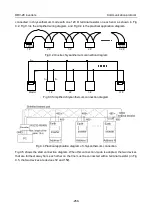
DRV-28 inverter
s Communication protocol
-260-
of 3.5 bytes). On a network where the transmission rate is calculated based on the baud rate, the
transmission time of 3.5 bytes can be easily obtained. After the idle time ends, the data domains are
transmitted in the following sequence: slave address, operation command code, data, and CRC
check character. Each byte transmitted in each domain includes 2 hexadecimal characters (0–9, A–F).
The network devices always monitor the communication bus. After receiving the first domain (address
information), each network device identifies the byte. After the last byte is transmitted, a similar
transmission interval (the transmission time of 3.5 bytes) is used to indicate that the transmission of
the frame ends. Then, the transmission of a new frame starts.
RTU data frame format
Modbus packet
Start with an idle time (at
least the transmission
time of 3.5 bytes)
Slave
address
Function
code
Data
Check
End with an idle time (at
least the transmission
time of 3.5 bytes)
The information of a frame must be transmitted in a continuous data flow. If there is an interval greater
than the transmission time of 1.5 bytes before the transmission of the entire frame is complete, the
receiving device deletes the incomplete information, and mistakes the subsequent byte for the
address domain of a new frame. Similarly, if the transmission interval between two frames is shorter
than the transmission time of 3.5 bytes, the receiving device mistakes it for the data of the last frame.
The CRC check value is incorrect due to the disorder of the frames, and thus a communication fault
occurs.
The following table describes the standard structure of an RTU frame.
START (frame header)
T1-T2-T3-T4 (transmission time of 3.5 bytes)
ADDR (slave address domain)
Communication address: 0–247 (decimal system) (0 is the
broadcast address)
CMD (function domain)
03H: read slave parameters
06H: write slave parameters
DATA (N-1)
...
DATA (0)
(data domain)
Data of 2×N bytes, main content of the communication as well
as the core of data exchanging
CRC CHK (LSBs)
Detection value: CRC (16 bits)
CRC CHK high bit (MSBs)
END (frame tail)
T1-T2-T3-T4 (transmission time of 3.5 bytes)
9.3.2.2 RTU communication frame error check modes
During the transmission of data, errors may occur due to various factors. Without check, the data
receiving device cannot identify data errors and may make a wrong response. The wrong response
may cause severe problems. Therefore, the data must be checked.
The check is implemented as follows: The transmitter calculates the to-be-transmitted data based on
a specific algorithm to obtain a result, adds the result to the rear of the message, and transmits them
















































